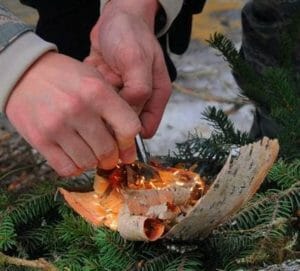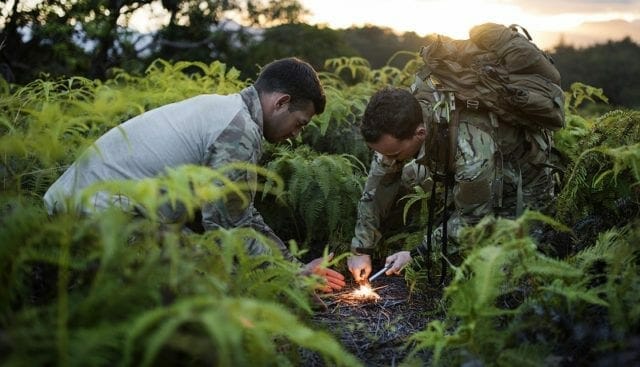The odds of surviving even the most serious calamity are that much better when you know simple, life-saving, survival strategies.
This is particularly important because in any calamity, you may realize that you are possibly the only one left alive.
If you find yourself in the middle of a wilderness area where the average wintertime temperature is 20º below zero, you’ll wish that you had a fire starter. More importantly, you’ll want to know how to use a fire starter. You want to be one of those people who can tell a story of how you were able to make it through a seemingly hopeless situation.
There’s No Need for Hopeless Surrender
With simple survival skills, there is no need to surrender to being a goner. Yes, matches are cheap, but sometimes a disaster can destroy your matches, then you will need to be resourceful with making do with what is available.
During an emergency, you want to be sure that you always have a couple of fire starters with you, and apart from matches and a flint starter, other DIY fire starters can be included in your emergency kit for uncertain times.
We Need Fire and Heat
 There are many ways that your body can lose important heat. Even if you have a sturdy jacket with a hood, fire will be a necessity for your survival. You’ll want a steady fire to keep you warm, to act as a rescue signal, to give you light so that you can get on with critical tasks, to boil and sterilize water, to cook food, to ward off encroaching wild animals, and as a morale booster.
There are many ways that your body can lose important heat. Even if you have a sturdy jacket with a hood, fire will be a necessity for your survival. You’ll want a steady fire to keep you warm, to act as a rescue signal, to give you light so that you can get on with critical tasks, to boil and sterilize water, to cook food, to ward off encroaching wild animals, and as a morale booster.
Orange, yellow and red flames dancing brightly are enough to offer hope and inspiration to anyone, allowing you to think more clearly as you work out your survival strategy. Fortunately, fire is possible to come by, even when you don’t have a match to produce a flame in seconds.
3 Essential Elements for a Fire
Anywhere you make a fire, you will need 3 elements–a combustible material, oxygen and heat.
Whichever way you start a fire, even the most primitive survival fire starters can be such an important tool so that you can hang onto life for just a bit longer.
4 Ways to Start a Fire
Here, we look at ways to use some of the fire starters available to you, bearing in mind that it’s a good idea to always have a couple of ways to start a fire with you as a backup in case one fails.
1. Wood Friction Fire
Surely, this has to be one of the oldest forms of fire starters. Adventure Bear Grylls may make it look like a piece of cake, but in fact, it isn’t.
Still, you need to know this rubbing-two-sticks-together technique, as it can just be that you’re able to get it right in a catastrophic situation. When two objects, such as dry sticks, are rubbed vigorously and continuously together, they generate heat, and if enough heat is generated, combustion comes about.
Make a tinder nest for your spark. If your tinder bundle isn’t dry and fine enough, you’ll battle to transfer fire from your hot ember to the tinder bundle. Have larger sticks ready to feed the kindling. Believe me, this isn’t the easiest way to start a fire, and often the pain in your hands becomes such that you give up before you can establish a glowing ember. If you’re desperate, however, you can get it right and it can save your life.
2. Mini Fire Starter Kit
We’re living in the 21st century, so rightfully you should have a mini fire starter kit in your home, your car,and your backpack. Its sheer simplicity is a winner. These nifty little kits work in any kind of weather–rain or snow─and they work when it’s wet, too. Weighing as little as 1.1 oz., these fire starter kits can light up to 15 fires and come with fire puffs and a magnesium striker–all packed in a zip lock bag. You simply use the amount you need, and the best part the kit fits easily into your pocket. Nobody who goes hiking or camping should be without this on-the-spot fire starter and you can buy refills, too.

3. Lying-around-the-Home Items
Every outdoor enthusiast knows that to get a fire started, you need easy-to-burn materials, and dead, dry leaves or dry grass and twigs abound around us. However, if you’re in the city and caught in an emergency situation,such as an earthquake at home, you may have to fall back on any household items you can get your hands on. Oily snack chips which are high in fat will light easily and even that lip balm in your bag can be hauled out, smeared on paper, and lit. The balm will help the paper burn longer while you hunt for other items to feed your fire with. A tip for future use is to start saving some cardboard. Simply cut cardboard into strips, dip them in wax, allow to dry, and store. You can even pack a few smaller pieces in your backpack for your next hiking or camping trip.
4. Magnifying Lens
How lucky you are if you wisely carry a small magnifying glass in your bag. With dry newspaper, crunched leaves or dry wood, when the sun shines you’ve got hope. Any clear lens made of glass or even plastic can be used as a survival fire starter. Simply hold the lens above the tinder pile you’ve prepared, moving it till you get a bright white point of light on your dried leaves or piece of newspaper. The smaller you’re able to make this point of light, the quicker it heats up, and you see that encouraging smoke appear. A magnifying lens is light and portable, and when you travel, there’ll surely be place in your bag for this life-saving, small device. In an emergency situation, you can even try to use your empty water bottle as a lens.
Final Thoughts:
With so much information available to you on how to recognize possible fire starters, you have various, innovative ways to get a fire on the go for emergency warmth and medical assistance. However, it’s all very well having the information, but it will be of no value if you don’t know how to use a fire starter. and how to put the information to use.
Practice a few fire-starting techniques to test your knowledge and to also refine your skills. This is so that when you’re caught in an emergency, you can keep a cool head as you go through the processes to get that fire of hope on the go.
